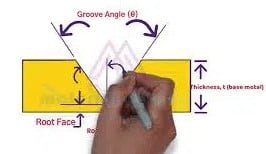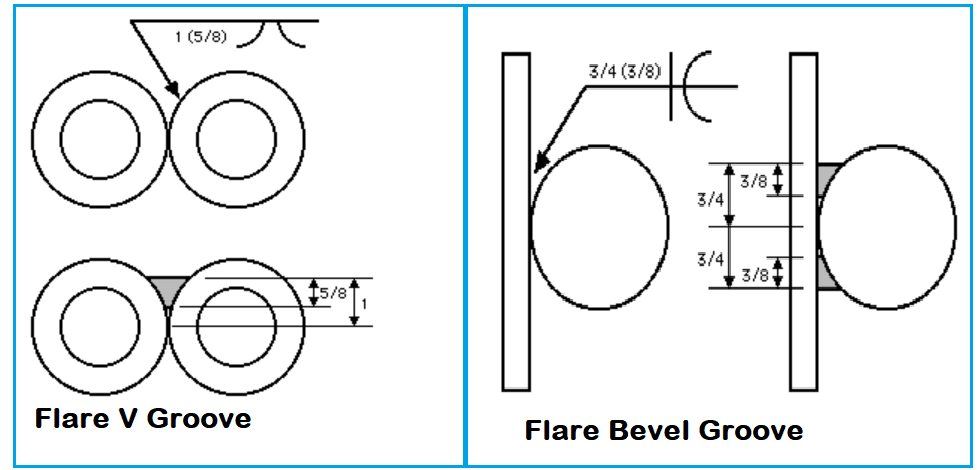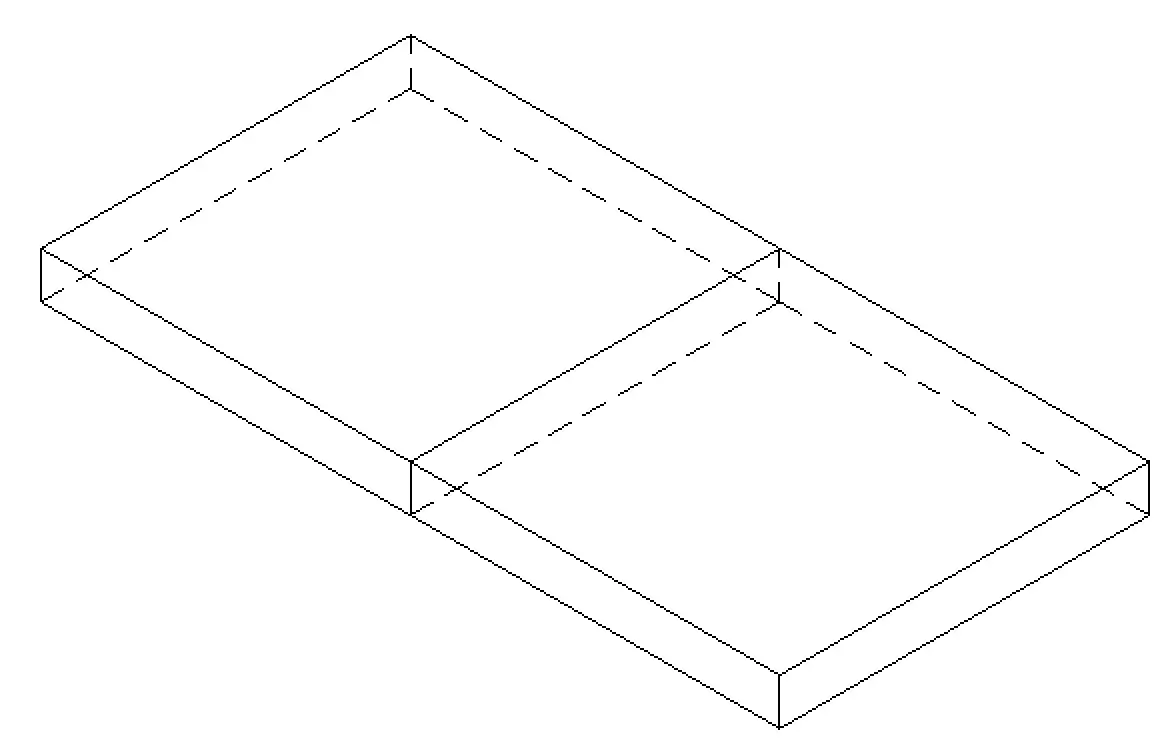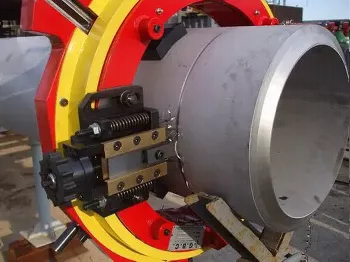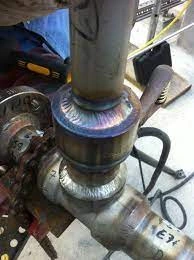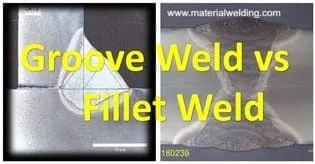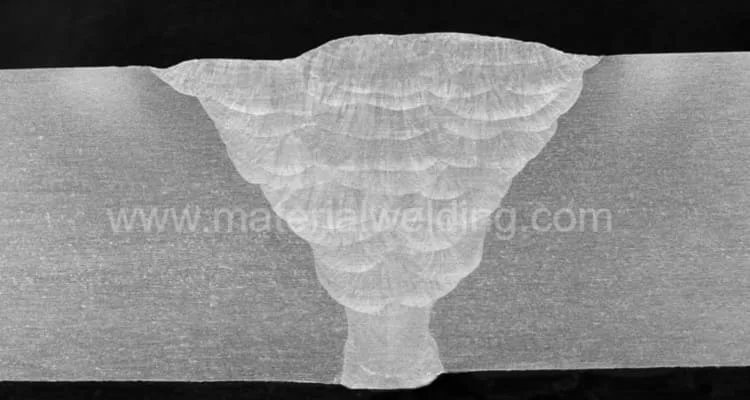What is a Welding Groove?
Before we jump to Welding Bevel, let us first know about Groove Welding. A welding groove is a weld joint type that is created by forming a bevel (taper recess) on the surface of the workpieces to be joined.
The purpose of the welding groove is to increase the weld deposit by providing more welding surfaces.
Welding grooves can be prepared using a variety of methods, including machining, grinding, gas cutting, laser cutting, special-purpose beveling machines, and EDM.
There are different types of Welding grooves as shown in the below picture. In the case of a Single-V Groove, both sides of base metals are beveled in equal dimensions to create a V-shape groove at the welding joint.
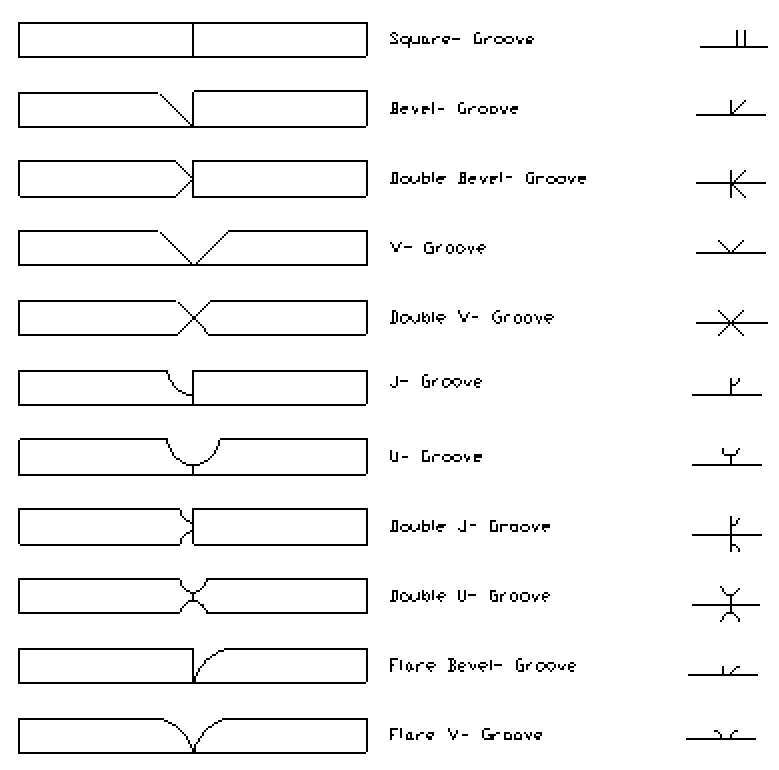
The other most commonly used Groove weld for thick plates/ pipe is Double-V Groove joint. In a double V-groove, the bevel is prepared on both sides of the base metals.
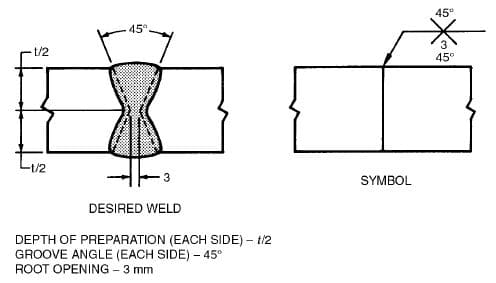
A welding Groove is created by making two V-shaped grooves in the joint faces, then welding the sides of the grooves together.
The resulting weld deposit has greater strength than a fillet weld of the same size, making it ideal for high-stress applications.
Weld Beveling Meaning
Weld beveling is the process of creating a bevel on the edge of a base metal for welding & joining applications.
Welding bevel refers to the angular edge shape on the base metal of the welding joint. There are different types of weld bevels (as shown in the below picture), and each has its own purpose.
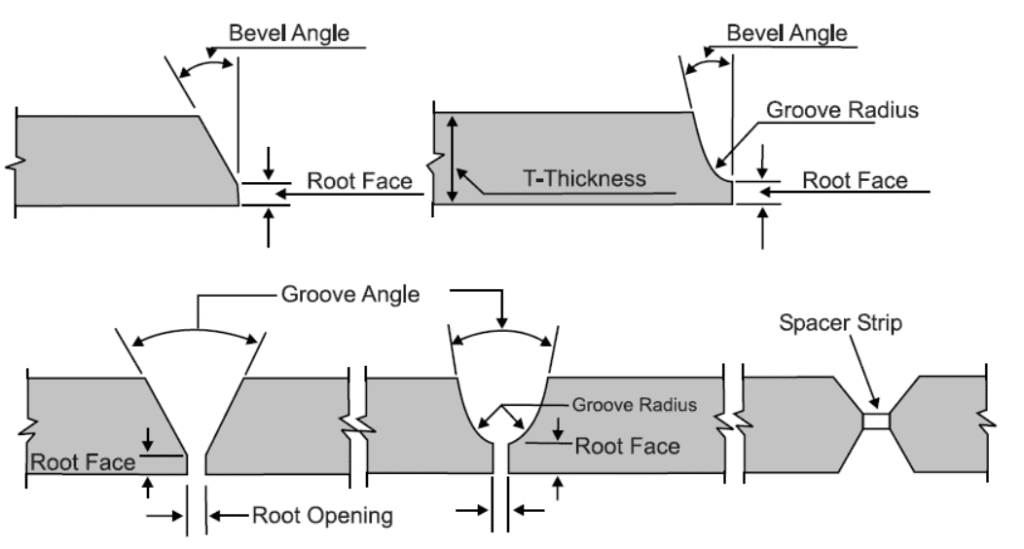
The most important thing to remember about weld bevels is that they affect the penetration and ease of welding.
It is important to choose the right weld bevel for the job. Incorrect bevel angle or poor weld bevel penetration directly affects the welding quality.
A welding bevel has the following terms that define the characteristics of a weld bevel:
- Bevel angle
- Bevel face
- Bevel radius
- Type of bevel preparation
Recommended Weld Bevel Preparation
Below are the recommended weld bevel preparation (angle, root face and root gap) for the following welding joint types:
- Single V- Groove,
- Single Bevel,
- Single V-Groove with Backing,
- Single Bevel with Backing,
- Double V-Groove,
- Double Bevel,
- Single U-Groove,
- Single J-Groove,
- Double U-Groove,
- Double J-Groove.
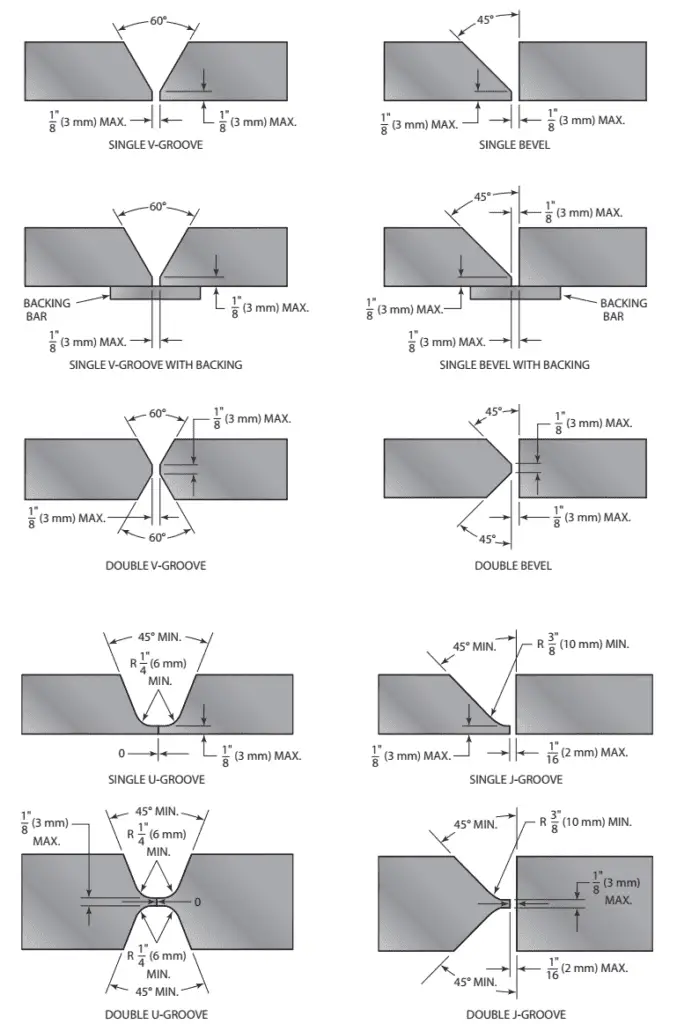
What is Groove Welding?
In welding, groove welding is a type of weld made by forming a V-shape with the two pieces of metal to be joined and then filling the space with a molten filler metal.
The edges of the V-shape are then welded together. Groove welding is often used in high-stress applications because it creates a strong weld.
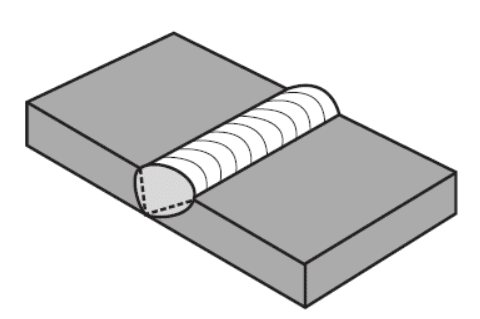
What is a Bevel Weld?
Bevel welds are created when the edges of two pieces or only piece of metal are having an edge surface preparation at an angle for welding.
This type of weld is more difficult to create than Fillet welds, but it is also much more durable & more strength. Example of bevel welds are shown earlier in this post.
Bevel welds are often used in heavy-duty applications where strength, high stresses and durability are essential.
This type of weld is often used in high-stress applications, as it provides more strength and stability than a traditional weld.
What is Beveling?
Beveling is a welding joint preparation technique that creates a V-shaped, J-shaped or U-Shaped groove on the edge of the weldment material. The beveled surface provides a greater weld area and helps to increase the welding joint strength.
When welding a joint, beveling the edges of the metal is an important preparation step. Beveling creates a smooth transition between the two pieces of metal being welded together. This helps to create a strong weld and prevents the formation of any weak spots.
There are several ways to bevel metal, but the most common method is to use a grinding wheel.
The grinding wheel is mounted on a grinder and used to grind away the edge of the metal. The amount of material that is removed will determine the size of the bevel.
Beveling should always be done before welding the joint. Always ensure the right bevel angle, smooth bevel surface and contamination-free weld bevel for high-quality welds.
What is Root Face in a Weld?
The root face (land) is the weld surface that is located at the root of a weldment. The root face is the perpendicular length from the root side of the base metal surface to the bottom edge of the weld bevel.
It is important to have a good weld root face because it affects the quality of the weld fusion and the strength of the weld.
Below figure A shows a broad root face in bevel preparation while Figure B has a zero root face.
You can find the recommended root face & gap for different types of welding joints in AWS D1.1 Structural welding code.
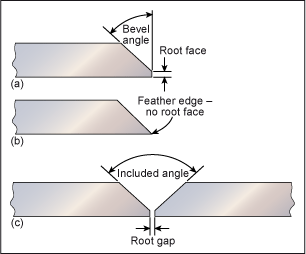
Usually, welding processes that produce low heat input require minimal root face as a large root face needs more heat to penetrate & give full weld penetration.
Larger root faces are useful for high-energy welding processes such as SAW, Plasma and Laser Welding.
The root face is important because it provides a smooth surface for the weld fusion to take place. If the root face is not properly prepared, it can lead to poor weld fusion and create a weak joint.
Root Opening Weld (Root Gap)
The preparation for a root opening (Also called Root Gap) weld is very important. The surface of metal must be clean and free of any contaminants.
The surfaces that will be welded together must also be perfectly aligned. If the surfaces are not aligned, the weld will not be full penetration, and it will likely fail due to high low (Misalignment).
Root gap example for a T-Joint (Fillet weld) and Groove weld are shown in the below example.
While a root gap is beneficial for groove weld as it assists in full penetration weld, a root gap in a fillet weld is not desired. The root gap presents if in a T-Joint or fillet weld will reduce its strength.
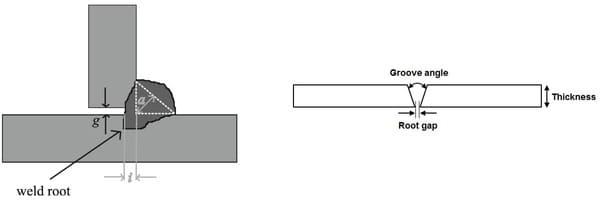
It is important to make sure that the root opening is of sufficient size (neither too big nor too small), so that there is full penetration at the weld joint. Recommended root opening (root gap) for groove welds/ butt weld is generally 3/16 inches- 5/16 inches (2mm – 3 mm).
If there is too much/ too less space between the two pieces of metal, the weld filler material will not reach all the way across, and you will end up with a weak spot in your weld with insufficient root fusion or root penetration.
Beveled vs Chamfered
Beveled and chamfered edges are both common ways to prepare the edge of a metal plate for welding, woodworking & machining. But what’s the difference between beveled and chamfered edges?
There are a few different ways to prepare the edges of the metal before welding, and each has its own benefits. Beveling the edges is one way to prepare them, and it is done by cutting off a small amount of metal from the edge so that it is angled.
Chamfering is another way to prepare the edges, and it is done usually by machining. While the term beveling is related to welding, the chamfering term is used for machining applications. Chamfering is used in machining & woodworking to eliminate sharp edges.
When we say Chamfering, the angle of the bevel is 45° but when we use explicitly Bevel, the angle of preparation can be of any degree (E.g., in welding usually bevel angle is kept from 30°- 70°.
Beveling is the process of creating a sloping edge on a metal plate. Beveling is done with a grinder or, more often, with a torch. The beveled edge makes it easier to weld the metal plate because the heat from the welding process is distributed more evenly across the surface of the metal.
Fillet Weld vs Groove Weld
Fillet welds and groove welds are two different types of welds that are commonly used in welding. Both weld types have their own advantages and disadvantages, which is why knowing the difference between them is important.
A fillet weld is a type of weld that is created by joining two pieces of metal at a 90-degree angle to each other. The fillet weld gets its name from the fact that the welding seam forms a triangular shape, with the base of the triangle being the two pieces of metal that are being joined.
Fillet welds are often used in structural fabrication because they are quite strong and relatively easy to make. An example of a Fillet Weld & along with its Welding Symbol is shown in the below picture.
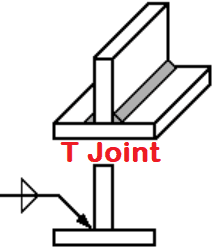
Groove welds, on the other hand, are created by welding two pieces of metal together in a straight line. An example of a Groove Weld is shown in the below picture.

When discussing fillet welds and groove welds, the first thing to understand is their difference in strength.
A fillet weld is weaker than a groove weld because the welding process joins the metal at a single point & not through the thickness like in a groove weld. This can cause the metal to become weak at non-fusion zone and susceptible to breaking.
However, a fillet weld is easier to make and requires least weld preparation. For these reasons, it is often used for joining structural parts. A groove weld is stronger because it joins the metal through the full thickness.
This makes it less likely to break, but requires additional weld preparation and higher weld metal.
Fillet welds are triangular in shape, while groove welds are straight. Both types of welds have their pros and cons, so it is important to choose the right type of weld for the job.
Similar Posts:
